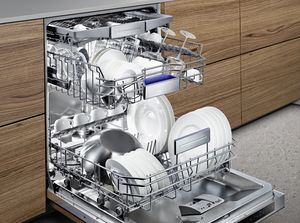Zeolite drying
What do an energy-efficient dishwasher and a self-cooling beer keg have in common? At first glance, very little of course. But a closer look at the inner workings of both inventions reveals a fascinating material: Zeolite.
What is Zeolite?
Zeolite is a mineral that occurs naturally in volcanic rock and is produced synthetically for technical use. It has very special properties that developers at BSH took advantage of. "Zeolite is especially suitable for this purpose because it has a crystal structure with a very high inner surface and a large number of channels. 1 kg of Zeolite covers the same surface area as 140 soccer fields! Its water absorbency is thus extremely high," explained Kai Paintner, Group Leader for Advance Development at BSH[1] in Dillingen, who was responsible for the process development referred to as the "sorption process".[2]
In collaboration with the Center for Applied Energy Research e.V. (ZAE), the dishwasher plant in Dillingen developed the then most energy-efficient dishwasher in the world in 2008 with the aid of Zeolite. The partners received the Bavarian Energy Award and the German Innovation Award for Climate and Environment for their development in 2009.
How does Zeolite drying work in dishwashers?
Zeolite is of critical importance for sorption drying as the process is termed scientifically. Sorption drying consists of two phases: the adsorption (or extraction of moisture) and the desorption (return of moisture).
During the adsorption process, the porous Zeolite granulates in the dishwashers absorb the moisture from the air in the interior and store this.
This releases energy in the form of heat. The warm air then flows back into the dishwasher interior, further accelerating the drying of the dishes and thus shortening the dishwasher program. The water remains in the zeolites at the end of the program.
Im nächsten Waschvorgang nutzt der Geschirrspüler das gespeicherte Wasser wieder: Die Zeolith-Granulate werden erhitzt und geben das Wasser als feuchte Luft in den zu Beginn kalten Spülprozess ab, in dem es kondensiert. Dadurch regeneriert sich das Zeolith-Granulat und kann in der Trockenphase wieder Wasser aufnehmen.
Weniger Energie hilft der Umwelt und spart Geld
Es braucht weniger Energie, die Zeolith-Granulate zu erhitzen, als das Geschirr im Spülinnenraum. Diese Einsparung lässt sich messen: bis zu 0,2 kWh pro Spülgang oder bis zu 20 Prozent weniger Energie.[3]
Wenn alle herkömmlichen Geschirrspülgeräte in Deutschland durch Zeolith-Geräte ersetzt werden würden, dann würde die Atmosphäre jährlich um rund 1,2 Millionen Tonnen CO2 entlastet werden. Dies entspricht dem Ausstoß von etwa 600.000 Personenautos, die eine Jahresleistung von 15.000 Kilometern jährlich zurücklegen.[4]
Das macht den neuen BSH-Geschirrspüler mit Zeolith-Technologie zum damals energieeffizientesten Geschirrspüler der Welt. Diese Innovation wurde 2009 zweimal honoriert: mit dem Bayerischen Energiepreis und dem Deutschen Innovationspreis für Klima und Umwelt des Bundesministeriums für Umwelt, Naturschutz, Bau und Reaktorsicherheit sowie des Bundesverbands der Deutschen Industrie.[5]
Die Zeolith-Trocknung ist wartungsfrei und hält ein Geräteleben lang. Die Technologie bietet noch weitere Vorteile: Wenn am Ende des Programms die Tür geöffnet wird, gibt es keine Dampfwolke und das Geschirr ist handwarm, so dass man sich beim Ausräumen nicht mehr die Finger verbrennt.[6]
Einzelnachweise
- ↑ BSH was founded in 1967 as Bosch-Siemens Hausgeräte GmbH - BSHG for short. In 1998, the name was changed to BSH Bosch und Siemens Hausgeräte GmbH, with the short form BSH. Since the sale of the Siemens shares in BSH to Robert Bosch GmbH the company’s name is now BSH Hausgeräte GmbH, but still BSH for short.
- ↑ BSH Corporate Archives, A05-0032, inform 2009/2 June, page 27.
- ↑ Ebd.
- ↑ http://www.iku-innovationspreis.de/iku-info/preistraeger/archiv/preistraeger-2009.php (abgerufen am 24.11.2016).
- ↑ BSH-Konzernarchiv, A05-0032, inform 2009/2 Juni, S. 27.
- ↑ Ebd. http://www.iku-innovationspreis.de/iku-info/preistraeger/archiv/preistraeger-2009.php (abgerufen am 24.11.2016).
